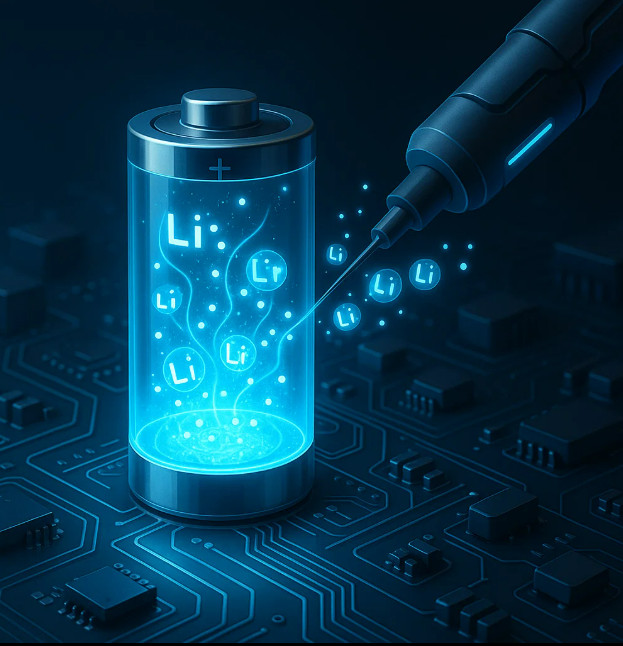ь ыА ыІЌэЌ ьЙыЃ: ыААэАыІЌь эьЖь ьДыы эь ъИАь
ыІЌэЌьДьЈ ыААэАыІЌ, эы ъИАь ь ьЌьЅ
ыІЌэЌьДьЈ ыААэАыІЌы эы ыЌИыЊ
ь ьЇэБэы эЕьЌ ьыьЇ ьЅьЙыЄ. ьЄыЇэИэАыЖэА ь ъИАьАЈ, ьЌььыьЇ ь ьЅьЅьЙъЙьЇ, ъБАь ыЊЈы ьДыэ ь ьъИАъИАь ыы ЅььДьЇыЇ ьыЊ
ь эъГъА ыЊ
ээыЄ. ьМыАь ьМыЁ 1,000~2,000э ь ыь ьЖЉыАЉь ьДэ ыААэАыІЌ ьБыЅь ъИъВЉэ ь эыыЉА, ъВАъЕ эъИАыыЄ.
ьДы ыЇыэ ьь ыыЙьДь эъВН ьЄьМь ььИьД ыъГ ьыЄ. ъЗИыЌы ьЕъЗМ эИыЈыэъЕ ьАъЕЌэьД ыАээ ъИАь ь ьД ъГ ьЇь ьИ эъГыЅМ ыЄэыЄъГ ьыЄ. ыІЌэЌьДьЈ ыААэАыІЌы э ыВ ыЇыЄьДьЇ э ь ь 'ыьДъАы' ьыЊ
ь эМэ ь ьыЄы ъИАьЁД ььь ь ыЉДьМыЁ ыЄьы ьАъЕЌыЄ.
ьИыЖ ыІЌэЌ ьЃМь
ьДыМы ь эь
2025ы
, эИыЈы ьАъЕЌьЇь ьИъГь ъГМэ ь ыьИ уыЄьДьВ(Nature)уь ыІЌэЌьДьЈ ыААэАыІЌыЅМ ыЖэДэьЇ ьъГ ы ьЌььэЄы ъИАь ь ыАээыЄ. эЕьЌь 'ьИыЖ ыІЌэЌ ьЃМь
(External Li supply)' ыАЉььДыЄ.
ъИАьЁД ыААэАыІЌ ь
ь ыІЌэЌьМ ьЉьЁ(LiSOтCFт)ь ьЃМь
эЈьМыЁьЈ, ьъАьД ьЇыыЉА ььЄы ыІЌэЌьДьЈь ь ъЗЙ ыДь ыЄь ъГЕъИэъГ ьБыЅь эыГЕьэЄы ыАЉььДыЄ. ыыМьД ь ь, ьДыЅМ ьэД ь
ь ыЖэДэъБАы ъЕЌьЁАыЅМ ыГъВНэ эь ььД ыЈьэ ьЃМь
ыЇьМыЁы эыГЕ эЈъГМыЅМ ьЛь ь ьыЄы ь ьДыЄ.
ъИАьЁДь ьЌьЌьЉ ъИАь ьД ыГЕьЁэ эДьВД, ыЖыІЌ, ьЌьЁАыІН ъГМь ь ьыАэы ыА ыЙэД, ьД ъИАь ь ь ьЇыГДьь ъАы
ь ъАъЙьИ ь ыыЁ ъАэИэыЉА ъВНь ь ьДыЄ. ыААэАыІЌыЅМ ьМьЂ
ь 'ыІЌэЌ ьАыЃэЕ'ьМыЁ ыАыМыГДы ьыЁьД ъДь ь, ъЗИ ььВДыЁ ыААэАыІЌ ьАь
ь ьВ эь ыЄьЇыыЄ.
ыьъА ьДыЌэ ьЃМь
ыАЉьь ьыэы ыІЌэЌ ьЃМь
ьЅьЙыЅМ эЕэД ььА ьВДъГьы ь ьЉэ ь ьы ъАыЅьБь ыДэЌэъГ ьыЄ. ь ъИАьАЈыЅМ ьДээыЉДь ьЃМъИАь ьМыЁ 'ыІЌэЌ ыГДьЖЉь'ь ыЄыЌ ьЖЉь ъГМ эЈъЛ ьБыЅ эыГЕь ыАы ыЏИыь ыЊЈьЕы ььэДыГМ ь ьыЄ.
AI ъИАыА ыЖь ьЄъГь эь
ьД ъИАь ь ыААъВНьы ьИъГЕьЇыЅьД ьыЄ. ьАъЕЌьЇь AI ъИАыА ыЖьыьэ ьыЎЌы ьДь
ь эЕэД ьыАБ ъАьЇь эыГД ыЌМьЇь ыЖьэъГ , ь ъИАээь ьМыЁ ьь ь ьДыЉА ыААэАыІЌ ыДыЖ эъВНь ь эЉэ ыІЌэЌьМь ыьЖэыЄ. ъЗИы ъВ ь эы ъВьД ыАыЁ ыІЌэЌьМ ьЉьЁ(LiSOтCFт)ьыЄ. ьД ыЌМьЇь ыААэАыІЌ ыДыЖыЁ ыЄьДъА э ыЙ ыЅДъВ ыЖэДыьД ыІЌэЌьДьЈь ыАЉьЖэъГ , ььЌ ьБыЖь эыАьБ ъАьЄыЁ ыГэД ъЕЌьЁАь ьэЅь ыЏИьЙьЇ ьыыЄ.
AIы ыЈьэ ъГьА ыГДьЁАъА ьыыМ, ыЌМьЇь ьэИььЉь ььИЁэъГ ьЄэь ьэьАЉьЄыЅМ ьЄьДы ьэ ь эыЄ. ьДы ььЌ ъГМэь эЈыЌыЄьь 'ьЄэ ьЄьЌ'ьь 'ььИЁ ьЄьЌ'ьМыЁ ыАъОИы ъИАь ь ьЇыГДьДъИАы эыЄ. ыэ ьД ь ъЗМь ьАъЕЌъАыА ьыыЅМ эъИАь ьМыЁ ыьДьЌыІЌыЉА, ььЌ эььь ыАьДэА ъИАыА ьЄъГъА ъАы ьЄьЇь ьы Ѕь ыГДьЌьЄыЄ. ьДы эЅэ ь ьЇ ььЌ ъАыАыП ьыыМ ыАыьВД, ьДыЇЄ, ь ьН ыБ ыЄыЅИ ыЖьМыЁы ььЉьД ъАыЅэыЄ.
ьыЊ
, эЈьЈ, ьЇь ъАыЅьБь ьМыАь ьЖЉьЁБ
ьЄэ ъВАъГМы ьыь ьДьыЄ. ььЉ LFP(Lithium Iron Phosphate) ыААэАыІЌ ь
ьь 11,818эь ьЖЉыАЉь ьДэьы ьДъИА ьЉыь 96%ыЅМ ь ьЇэыЄ. ьДы ъИАьЁД ьыЊ
ь 5~10ыААь эДыЙэыЉА, ь ъИАьАЈ ыААэАыІЌь ъВНь ьБъГМ ьЇьъАыЅьБь эъИАь ьМыЁ ыьДьЌыІД ь ьы ььЙыЄ. ьАъЕЌьЇь ьДыЅМ эЕэД ьМыЖ ь
ь ьЕы 6ыЇ эъЙьЇы ьБыЅь ь ьЇэ ь ьь ъВьМыЁ ь ыЇэыЄ.
ъИАьЁД ыААэАыІЌы ьъАьД ьЇы ьыЁ ыЖъАьь ьИ ьДэъА ыАьэьЇыЇ, ьИыЖ ыІЌэЌ ьЃМь
ь ьДыЅМ ьМь ььЄьь ыыыІД ь ьыЄы ь ьь 'ьыАЉэЅ ьыЊ
ь ьД'ыМы ьыЁьД ъАы
ь ь ьэыЄ. ъИАь ь ьМыЁы ъВНь ь ьМыЁ ыЊЈы эЈьЈьБь ъЗЙыээ ь ьы ыЊЈыИьДыЄ. ыэ ь ъИАьАЈыП ьыыМ эьъД ьыьЇ ь ьЅьЅьЙ, ыэ ESS, ыыЁ ыБ ыЄьэ ььЉ ыЖьМь эы ь ьЉэ ь ьы ь ьЌы Ѕы ыыЄ.
ыААэАыІЌ ьь ьЃМъИАь ьАь
ъЕЌьЁАь ь э
ьД ъИАь ьД ъАьЇ ьыЏИы ыЈьэ ыААэАыІЌ ьыЊ
ьАьЅь ыЈИыЌМьЇ ьыыЄ.
ьВЋьЇИ, ьь ьэь ъДь ьь эъИАь ьИ ь эь ьД ыыЄ. ьЇъИъЙьЇы ыААэАыІЌ ьыЊ
ьД ыЄэыЉД эъИАэъГ ьыЁ ъЕьВДэы ыАЉььДььЇыЇ, ьДь ы ьМь ьЃМъИАыЁ ыІЌэЌь ыГДьЖЉэЈьМыЁьЈ ьЌьЌьЉьД ъАыЅэДьЇыЄ.
ыьЇИ, эъВН ьИЁыЉДььы ь ьэъИАыЌМ ъАь, ыІЌэЌ ьБъЕД ъАьыМы ьДьЄ эЈъГМыЅМ ъИАыэ ь ьыЄ. ыЇьЇыЇьМыЁ ыААэАыІЌ ьАь
ь ъЕЌьЁА ььВДъА тьыЊЈэ ъИАыАтьь тьЇь ъАыЅ ъИАыАтьМыЁ ьЌэИы ь ьыЄы ь ьь ь ыЕь ъАьЙъА эЌыЄ.
ьыЅМ ыЄьД, ь ъИАьАЈ ь ьЁАьЌы ыЈьэ ыААэАыІЌыЅМ ъГЕъИыАы ыА ъЗИьЙьЇ ьъГ , ыААэАыІЌ ьЌь ьыЃЈь
ь эЈъЛ ь ъГЕэы ьыЙьЄ ъИАь
ьМыЁ ьЇээ ь ьыЄ. ьДы ьыьАЈ ьАь
ь ььЕъЕЌьЁАьы ьЇь ь ьИ ьэЅь ьЄ ъВьДыЄ. ыэ ьыЁьД ь ыЙ ьАь
ьД эьБыъГ , ыААэАыІЌ ь ьЇыГДьь ъДы Јы ьИьІ ъИАь ьь ьМэАъА эьэДьЇы ыБ ьМьыІЌ ьАНьЖ ьИЁыЉДььы ьыЏИ ьы ыГэыЅМ ъАь ИьЌ ь ьыЄ.
ььЉэыЅМ эЅэ ъГМь ыЄ
эьЇыЇ ыьДьМ э ъГМь ы ыЖыЊ
эыЄ. эьЌ ъИАь ь ь
ыЈьььыЇ ьЄэыьъИА ыыЌИь ыЊЈыьДы эЉ ыЈь, эЙэ ь ъИАьАЈьЉ ыьЉы ыААэАыІЌььь ь ьЉ ьЌыЖы ььЇ ъВьІыьЇ ььыЄ. ыэ ыЄьэ ээ ьЁАьБ—эЙэ ыьМ, ьНыАэИ ъГьД ыААэАыІЌ—ььы ыьМэ эЈъГМыЅМ ыМ ь ьыьЇь ыэ эь ьАъЕЌы эьэыЄ. ъЗь ь ьь ьБ ъВьІ, ыЙьЉ ъЕЌьЁАь ььА ъГЕь ь ьЌьЄъГ ьь ььЉэыЅМ ьэ эь ьЁАъБДьДыЄ.
ыЌДьыГДыЄ ьЄьэ ъВь ъИАь ьД ььЅь ьЇь
э ь ьы эьЄь ьЁАъБДь ьДыЛъВ ьЖЉьЁБьэЌ ь ьыъАьДыЄ. ьАъЕЌьЄь ьБъГЕьД ьАь
эьЅьь ыАыГЕ ъАыЅэДьМ ьЇь э эь ьД ыъИА ыыЌИьДыЄ. ъИАьЁД ыААэАыІЌ ь ьЁА ъИАь
ыЄь эы ЅьД эьь ьДыЉА, ъИАь ыМьДь ьЄ, ьИьІ ь ы, ьЌь ьЃМъИА ыЊЈыэАыЇ ььЄэ
ыБь ь ыэ ьь
ьД ыГэыьДьМ эыЄ.
ыААэАыІЌь ьИъАь ыЎьъМД
ъЗИыМьы ыЖъЕЌэъГ ьДыВ ьАъЕЌы ыЖыЊ
э ь эь ьДыЄ. ыЇьЙ ьЌыь ъБДъАь эыГЕьэЄы ъВьВыМ, ыААэАыІЌыЅМ тьЙыЃтэы ъАы
ь ыААэАыІЌыЅМ ыЈьэ ьыЊЈэьД ьы, ыыГДъГ ъДыІЌэ ь ьы ьыьЇ ьЅьЙыЁ ыАыМыГДъВ ыЇы ыЄ.
ь ъИАьАЈ ыГДъИьД ыГИъВЉэыы эьь ьь, ьДыЌэ ъИАь ь ыЈьэ эЈьЈьБь ыЌИь ъА ьыыМ ьЇь ъАыЅэ ыЏИыыЅМ ьэ ь эьЇыЁ ьЃМыЊЉыАыыЄ.
ыААэАыІЌ эьЖ ъИАь ь ъИАь ь ьИ ьЇыГДьДь, ььъГМ эъВН, ьАь
ь ььАыЅДы ь ыЕь эь ьДыЄ. ьДь ьАыІЌы ы ьДь ыААэАыІЌыЅМ ыВыІЌы ыь , ьЙыЃэъГ ьЌэьЉэы ьыыЅМ ыЇьДэъГ ьыЄ. ьДъВьДьМыЇыЁ ъИАь ьД ьЖъГМ ьЇъЕЌь ьЇь э ъАьЙыЅМ ыы ЄьЃМы ыАЉььМ ъВьДыЄ.
* Reference
Nature, 2025, тExternal Li supply reshapes Li-deficiency and lifetime limit of batteries, Gao Yue et al.т







